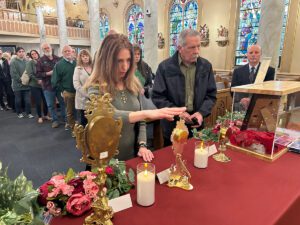SWOYERSVILLE – Hundreds of faithful visited Saint Elizabeth Ann Seton Parish on the weekend of March 15-16, as the Luzerne County church hosted seven relics of Saint Padre Pio, one of the most beloved saints in modern Catholic history.
Among the relics displayed was Padre Pio’s glove, a cherished item that helped connect the faithful to his life of extraordinary holiness.

“It’s a good opportunity to introduce Padre Pio to our parishioners and the public who might not know who he is,” Mark Perugino, Grand Knight, Knights of Columbus Council 12976, said.
The parish Knights worked with the National Centre for Padre Pio to bring the relics to the Swoyersville parish.
“It’s an honor for our parish to have these relics,” parishioner Stephen Englot said. “It was peaceful and uplifting being here today.”
Englot and his wife, Maria, have always felt a close connection to Padre Pio.
When their second daughter was suffering from a high fever at the age of four, Maria prayed to Padre Pio and asked for his intercession.
“I asked Padre Pio to please heal her before the day comes. The third time I checked on her, the fever was gone,” Maria recalled.
Saint Elizabeth Ann Seton Parish offered veneration viewing of the relics between 1-7 p.m. on March 15 and 8 a.m.-7 p.m. on March 16 with regular Masses held several times in between.
Like many others, Father John Chmil, pastor, has felt a closeness to Padre Pio for many years. When his mother had a stroke and was unable to walk or talk, he prayed to the beloved saint.
“She couldn’t walk or talk and now she’s 95-percent back with us. I give credit to Padre Pio,” Father Chmil said.
The long-time pastor said one of the highlights of the weekend for him was bringing his mother into the church and blessing her with one of the relics.
“I was overwhelmed with peace, and I began to cry, and I noticed my mother did too,” he added.
A native of an Italian farming village, Saint Padre Pio, born Francesco Forgione, became a Capuchin friar at the age of fifteen, dedicating his life to prayer, penance, and service to others.
Padre Pio bore the stigmata, or wounds of Christ, invisibly from the time of his ordination in 1910 and visibly from 1918. As his reputation as a confessor grew, the Vatican investigated the genuineness of his stigmata and ministry of prayer and healing.
Padre Pio built a hospital to treat patients using prayer and science, as well as a pilgrimage and study complex. Shortly before his death, the stigmata disappeared.
He was canonized as a saint by Pope John Paul II in 2002. Since then, he has inspired millions of Catholics worldwide with his unwavering faith and devotion.
Joseph Santoro, External Program Coordinator at the National Center for Padre Pio, who offered to bring the relics to Swoyersville, is not surprised at why the modern-day saint fascinates people.
“His life was full of holiness, sacrifice, and suffering, and people are drawn to that, especially during Lent,” Santoro said.
Saint Elizabeth Ann Seton Parish is the third local community to host the relics in recent weeks. On Feb. 23, Annunciation Parish in Hazleton hosted the relics, and on March 8, they were also venerated at Most Holy Trinity Parish in Cresco.
